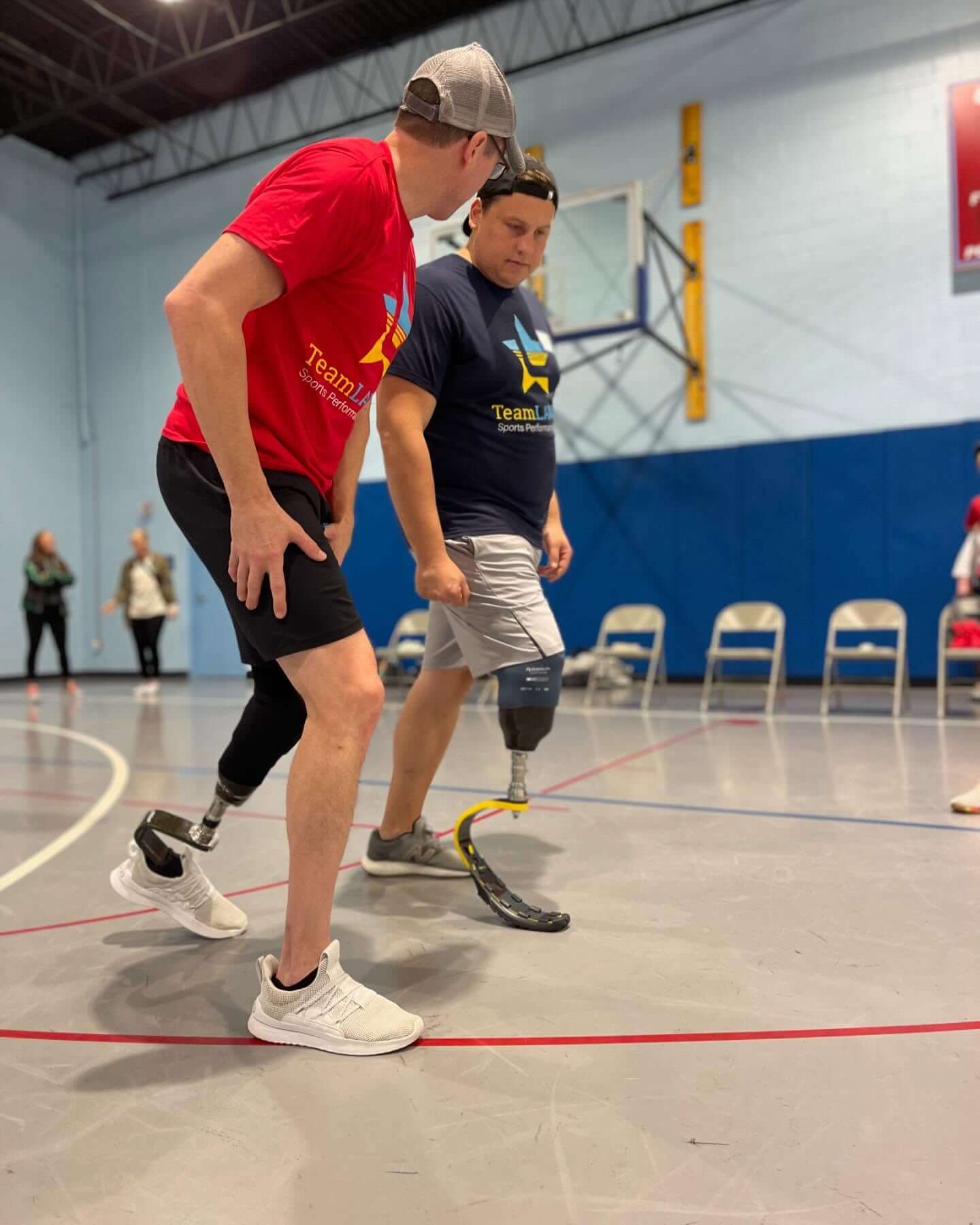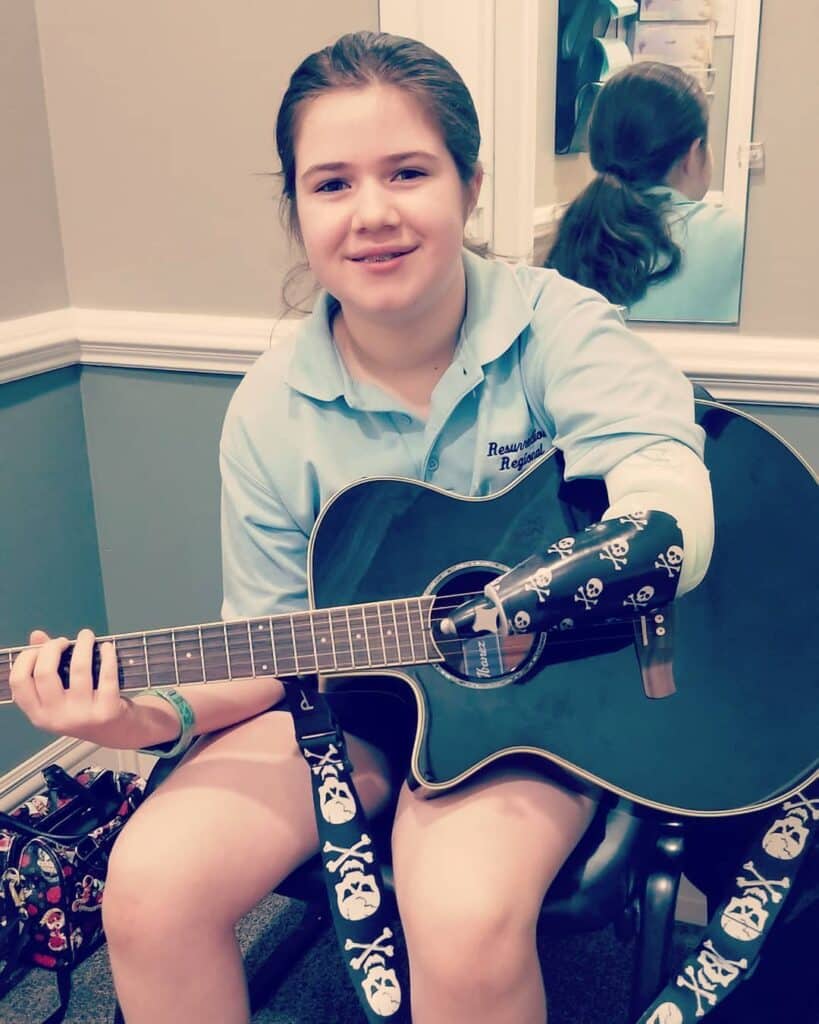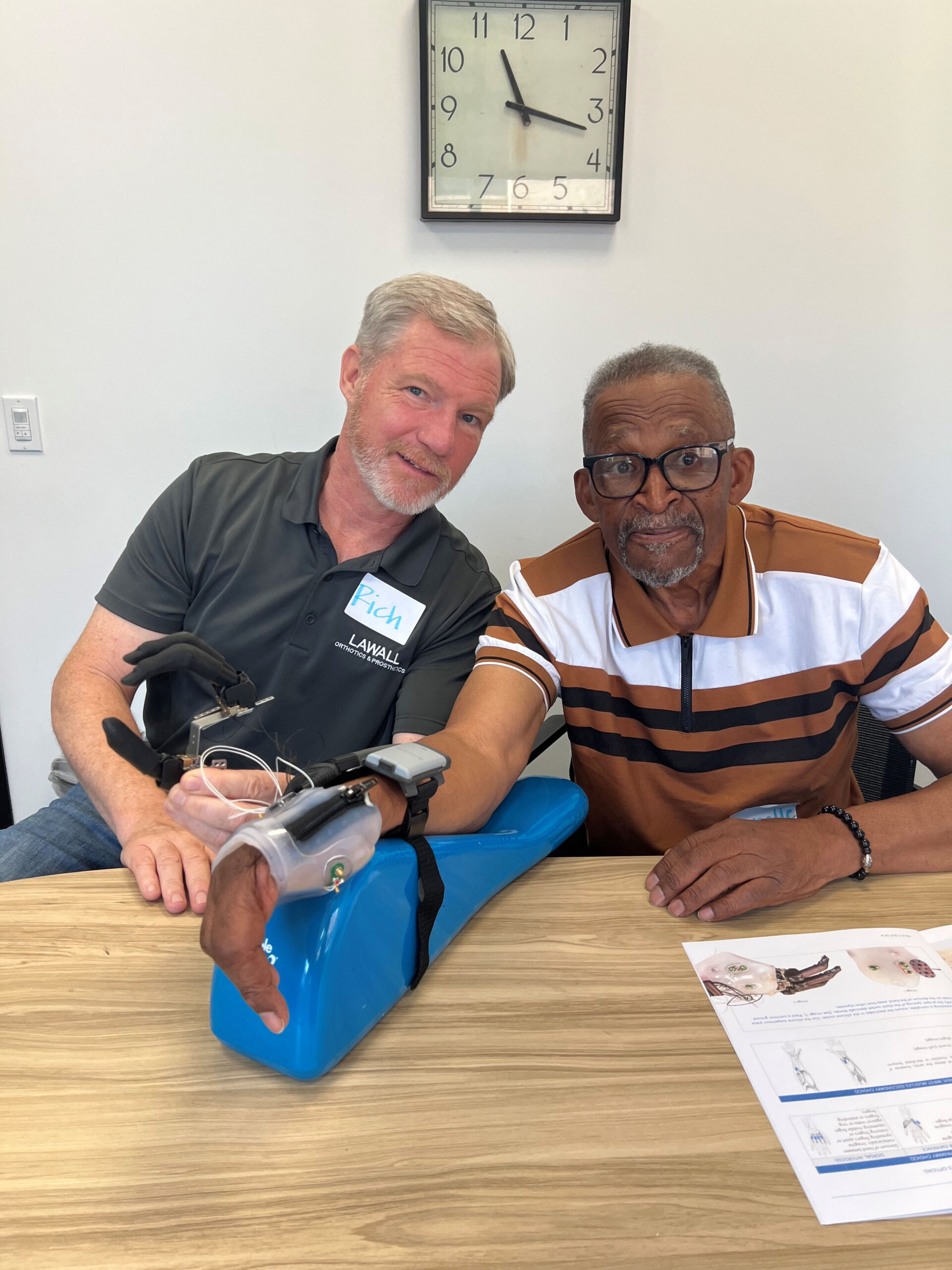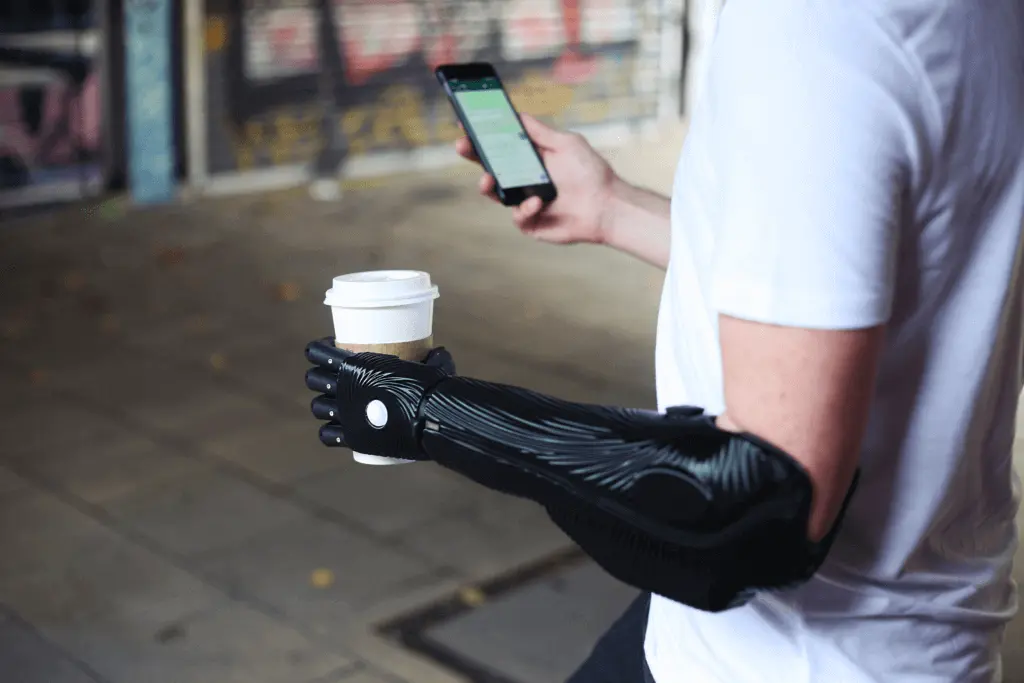Look in the dictionary under ‘precocious’ and you’ll probably find Isabella DiLeggi’s picture. Born in June 2008 as a forearm-level congenital amputee (a condition known as symbrachydactyly), she grasps life more enthusiastically and successfully with one hand than many 10-year-olds do with two.
In the beginning, however, the situation was frightening to parents uncertain of the life their little girl might face.
“We had no idea that Izzy would be born with a limb difference; we’d had a few ultrasounds and there was no cause for alarm, so when she was born it was quite a surprise,” Vicki DiLeggi recalls. “I remember being so scared and worried about what her future would hold.”
“Her primary care doctor didn’t have much information for us, but advised us to check out Shriner’s Hospital. Shriner’s recommended that we wait till she was six months old, and then have her fitted with a prosthesis for her left arm,” remembers Brian, a Philadelphia firefighter.
The idea was to allow Izzy to get comfortable with a prosthesis at an early age, making the choice—to wear one or not—easier for her as she grew older.
“For the most part,” he smiled reflectively, “she’d put it on to play with it—not because she wanted to use it to help her play, but because she wanted to physically play WITH the prosthesis as a toy! When she was actually doing things, everything was easier for her to do without the prosthesis than with it.”
After she outgrew the prosthesis—and a second one that she also largely ignored—the DiLeggi’s abandoned the idea of a prosthesis for several years, with the exception of an extension made by Shriner’s for her bicycle’s left side handlebar when she was three or four years old.
She outgrew that, as well, and now just rides a bike with adjustable handlebars she can customize to suit.
“The only thing we had to do was switch the hand brake from the left to the right-hand size of the bike,” Brian explains.
As the DiLeggi’s learned from experience, they also discovered the Lucky Fin Project, a 501(c)(3) nonprofit organization that raises awareness of children and individuals born with symbrachydactyly or other limb differences, and creates a support network for parents.
As Lucky Fin’s founder, Molly Stapelman, explains, “A child being born with a limb difference is not tragic. It’s extremely important to show our children how capable & wonderfully made they are. If we treat them as flawed or limited that is who they will believe themselves to be- and that would be the tragedy.”
When the DiLeggi’s first heard of the Lucky Fin Project, “it was just starting to gain ground,” Vicki notes, “and we became part of the Lucky Fin family. It was great to find families in similar situations and have that kind of support. To this day, we refer to Izzy’s left arm as her ‘Lucky Fin’.”
Izzy’s interest in all things musical began at a very early age. She was introduced to dance when she was just 2½ years old and continued to practice ballet for six years, until her preference switched to hip-hop—mostly because, as she told Vicki, “I can’t stand the tutus!”
Vicki sighs nostalgically at the memory. “I went from this little girl who was nothing but pink glitter and sparkles to a daughter fascinated by green camouflage and skulls and crossbones!”
Izzy’s interest in dance expanded into other musical areas. She also takes singing lessons and participates in a children’s choir, and has been taking guitar lessons for 1½ years.
With their usual “necessity is the mother of invention” approach to problem-solving, Brian and Izzy developed a home-made prosthesis that allowed her to use a guitar pick.
“When she decided she wanted to play the guitar, we didn’t know at the time that you could go have these things made,” Brian explains, “so we made one ourselves out of a plastic water bottle, a guitar pick, a rubber stopper from the bottom of a chair, and some purple duct tape to make it pretty.”
It worked pretty well, but not nearly as well as the ones that were later professionally made for her, he admits.
Through the Lucky Fin Project and facebook, they had met other musicians who had similar limb differences and played the guitar, but their solutions –like taping a guitar pick to their arm—didn’t work for Izzy. When their research led them to another young musician with a specialized professionally-made prosthesis, they consulted Shriners to see if one could be made for Izzy.
Shriners created a neoprene sleeve that had just an attachment at the end to hold her pick—which was not easy to adjust or remove. It was a vast improvement over the improvised DiLeggi model prosthesis, but Izzy found it somewhat awkward, because her sleeve “flopped” easily and made her strumming (picking) difficult to control.
The ‘small world’ principle came to their rescue: Chris and Kristy Robinson, parents of a boy on Izzy’s soccer team, also happened to work for a provider of prosthetic devices, and it happened to be Lawall.
“We were having difficulties getting her prosthesis elsewhere,” Vicki said, “and Kristy and Chris both recommended that we try Lawall. We worked with Wayne Lawall and Chris, and they were amazing! Izzy is a Rockstar, and they wanted to make sure she loved her prosthesis. So they made a special effort to match her prosthesis with the skull design on her guitar strap, and to find a silicone sleeve in her favorite color—green. She LOVES it!”
Chris Robinson, head technician at Lawall, explained that the prosthesis consists of a socket which is easily slipped on using her other arm, and held in place by a simple pin system. At the end of the socket is a special attachments that holds a single guitar pick that can be changed out––“and Izzy has a lot of different picks!” he notes.
“The attachment with pick is held in place by a set screw, but we can adjust the angle to where it’s most comfortable for her while she’s playing the guitar,” he adds.
The appearance of the prosthesis was Izzy’s choice, and “she was thinking outside the box a little bit!” Robinson chuckled. “She picked out a pattern of little skull bones that we laminated onto the socket.”
Izzy received her skull-themed prosthesis in September 2018 and she’s still happy that “It worked right the first time!”
Brian agreed. “As soon as they got it ready, she went in for the final fitting and took the guitar with her, and it was perfect! The prosthesis from Lawall was a substantial upgrade from her previous models!”
“She was a good patient,” Robinson reports. “-very enthusiastic! She was excited to be able to play, and from what I hear, she plays very well!”
Her Saturday guitar lessons at the Fox Chase Music School—where she plays a variety of styles of music, including 60s and 70s classic rock—are supplemented by free Friday evening rehearsals with 20-30 other members of the Fox Chase Prime Time Players, with whom she participates in six to eight concerts each year, playing for the enjoyment of audiences at senior living facilities, restaurants, and other public sites.
The band includes players of all ages—from second grade to high school and beyond—who perform with guitar, ukulele, violin, cello, and bass guitar (which Izzy has also mastered).
Although Izzy’s musical talents have been extended to the piano, as well, where she can now accompany herself as she practices her voice lessons, she admits that music will probably just be a hobby for her.
What might her career goals be?
She is currently enjoying acting classes, and recently played the title role in Act V of Rodgers and Hammerstein’s “Cinderella” as part of her 5th grade class’s assigned contribution to the Kimmel Center production.
But while acting may be exciting, when it comes to listing her favorite subjects, Izzy quickly names science and religion—and Brian reveals that although she despises it, her teacher has placed her in an advanced math class.
“Right now she’s at the age where she wants to be an actress, and a TV star and a movie star,” Vicki admits, “But she is a huge science geek! I say that in the nicest possible way, because we are actually a family of geeks. I remind her that being a geek is something she should be proud of, because it’s the nerds and the geeks who people seek out for their knowledge!”
Asked to predict Izzy’s eventual career direction, Vicki names “something science-based, somewhere in engineering; there are so many different aspects like digital engineering, that don’t depend on math!”
Izzy receives monthly boxed science projects via subscription—“Last month she built a little robot!” Vicki marvels, “—assembling all the gears and switches. Brian will assist, but usually she takes the directions, she goes to town—she knows what she’s doing! She’s made so many of these things and she loves them. I really think she’s going into a science-related field.”
As vice president of Resurrection’s home and school board, Vicki is keeping a close eye on possibilities for the next level of Izzy’s education, reviewing the STEM programs at area high schools brought in for a ‘high school night’ where elementary kids can look ahead and learn what’s available to them.
“I do want to make sure that she does go to a Catholic high school. Our faith is very important to us, so we really want to make sure she’s exposed to it,” she stresses. “When she’s 18 and makes the college choices and beyond, I hope she remembers everything we taught her.”
Fortunately, such situations have been rare, Vicki says, describing another little girl with a limb difference who was in Izzy’s daycare. Because there were two little girls with similar limb differences, it became normal for the other kids who quickly got used to them.
“When she moved to kindergarten, I was very nervous, but she came home on her first day of school announcing that she had a new friend named Danika who approached her, and asked what was wrong with her arm. When Izzy said, “Nothing!” Danika said, “Okay. Do you want to be my friend?”
“And to this day,” Vicki concludes, “they are still best friends.”
Wise beyond her years in the ways of diplomacy, this 10-year-old also serves as peacemaker and mediator between two strong-willed girl friends with equally strong opinions.
“There’s always girl drama going on somewhere within a circle of friends, but Izzy seems to be the diplomat in the group, presenting both sides so that everybody can meet in the middle,” Vicki notes. “I see that leadership ability, where she takes opinions in stride, and really does try to get to where everybody can just get along, without being one-sided.
A rare gift in any 10-year-old.
Asked if there’s anything she’s not able to do that she might want help with, Izzy replies with characteristic boldness, “I can handle almost anything!”
“—anything except the guitar,” Brian teases her with a grin.
“She just continues to amaze us,” he marvels. “Whatever problem we anticipate for her seems to end up being more our concern than hers!”
Vicki agrees. “Today, when I think about the worries and fears I had (when Izzy was born), I smile because these fears no longer even exist in my mind. If Izzy wants to do something, she’ll do it. Whether it’s tying her shoes, riding a bike or playing guitar, bass and piano – if Izzy wants to do something, she does it—differently. Sadly for me, this also applies to her hacking into my phone and Bitmoji account!”
For other parents wondering how best to support their child with a limitation, Vicki offers advice:
“I just learned by trial and error to just take a deep breath and know that they’re going to figure it out. The more we tried to help by figuring things out for her, the more she’d come back with her own fresh solution to the puzzle. They’re going to learn—maybe differently from how their friends do it, but they’ll each find their own way.
“Brian and I have told her, ‘Izzy, God knew that some people were special and they were smart and they could do everything. The other people God gave two hands.”
Embracing new experiences and challenges with confidence and finding her own way, Izzy delights in exploring new territory— composing music for her guitar, trouncing challengers in the video games she enjoys, and, ironically, lending a hand to others less gifted.
Sometimes, as the Lucky Fin Project points out, “Ten fingers are (indeed) overrated”!






